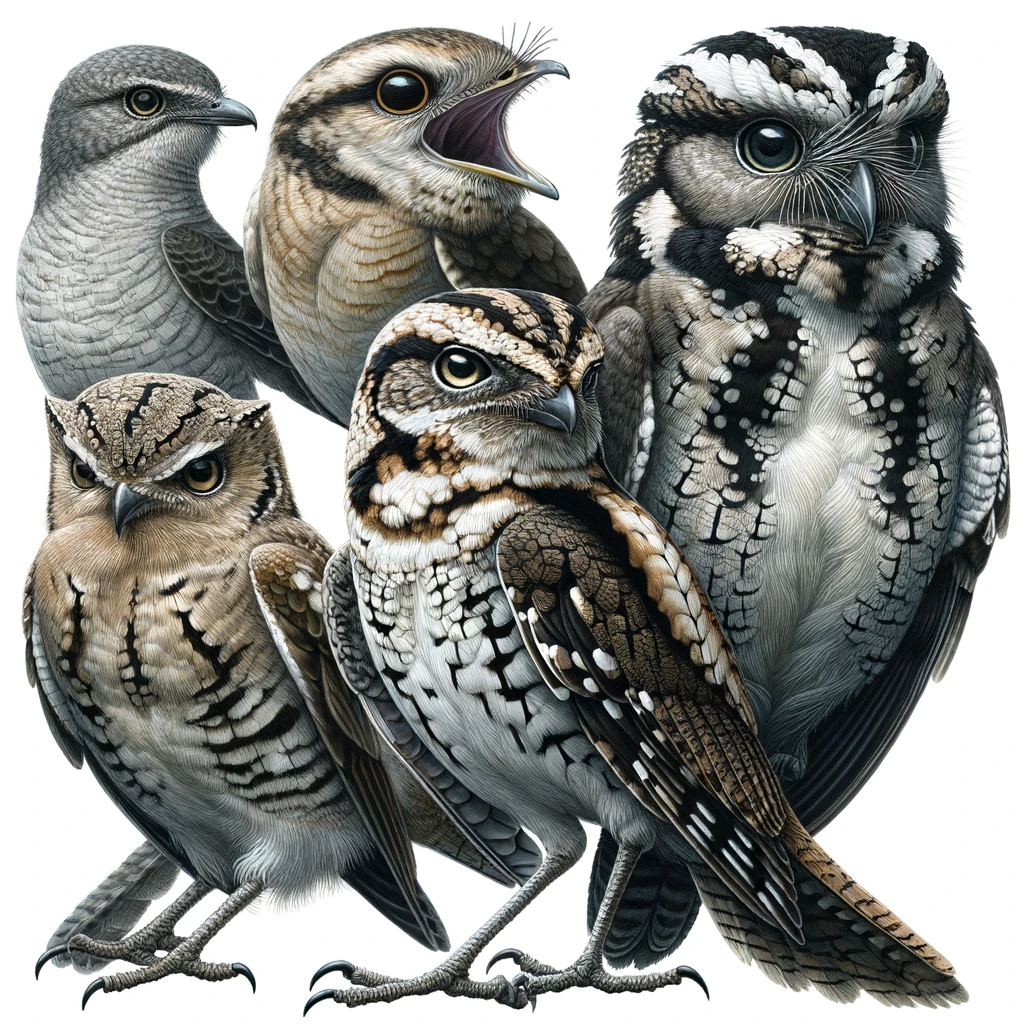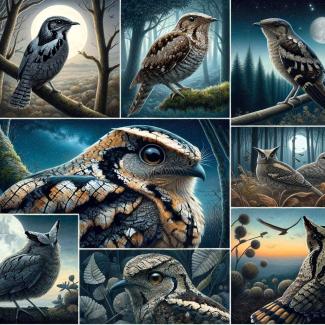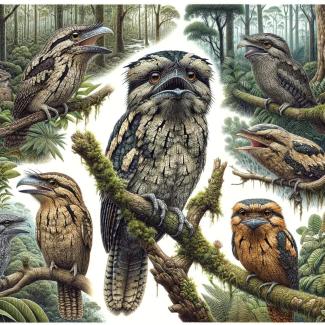
Encompassing a diverse assemblage of largely nocturnal or crepuscular species, Caprimulgiformes include nightjars, nighthawks, potoos, frogmouths, and owlet-nightjars. With over 120 species divided among 5 families, Caprimulgiformes possess a global distribution through the warmer parts of North and South America, Europe, Africa, Asia, and Australasia.
While some taxonomic authorities historically grouped Caprimulgiformes within the order Strigiformes alongside owls, contemporary genetic analysis supports the distinctive evolution of the two clades at least since the Eocene from separate ancestral stock. Unlike the aurally advanced but visually oriented owls, Caprimulgiformes rely more upon intricate camouflage patterns that encourage roosting amidst dappled forest habitats during daylight hours.
Yet despite unique convergent nocturnal adaptations, Caprimulgiforme member families themselves demonstrate impressive lifestyle diversity - from nighthawks that haw flying insects mid-air to ground-nesting nightjars and potoos that nab terrestrial prey.
Nonetheless, nocturnal habits facilitated the wide dispersal of ancestral forms across most landmasses through evolutionary time scales except the polar regions. Today Caprimulgiformes enliven evenings and forest understories on every continent except Antarctica.
Characteristics
Physical Features
Caprimulgiformes are mostly medium-sized members; from large frogmouths exceeding nightjar lengths 30 centimeters down to tiny owlet nightjars weighing just nine grams. Stocky bodies with rounded wings facilitate maneuverability in densely wooded habitats. Short bills and expansive, stiffened gaps aid in catching airborne insects or plucking arboreal prey.
Extremely cryptic plumage patterns utilizing mottles, streaks, ovals, and bars grant camouflage amidst sun-dappled understories. Grays, browns, tans and black prevail. Soft contour feathers eliminate noise during flight. Brush-tipped feather fringe along wing edges may further muffle wingbeats when hunting.
Behavioral Traits
Combining nocturnal and crepuscular activity restricts most observations of natural habits. But Caprimulgiformes tend to roost lengthwise on branches during daylight to avoid detection. While ungainly on land with diminutive legs set far back, some nightjars may drop to the ground to pursue terrestrial insects before fluttering back vertically.
Feeding occurs entirely in flight as the wide mouths capture aerial insects or pluck suspended arthropod prey from leaves. Superb low-light vision likely supplements non-visual prey detection at night.
Reproduction and Lifespan
Solitary nesters deposit two eggs atop leaf litter on the forest floor, trusting camouflage to protect clutches. Semi-precocial chicks possess innate mobility to flee disturbances shortly after hatching. Average longevity remains uncertain given cryptic habits but estimates suggest nightjars survive over 5 years and 10 years for potoos in the wild based on banded returns.
Extant families
Caprimulgidae (nightjars)
The largest family within Caprimulgiformes encompassing over 90 species, nightjars possess global distribution across warmer parts of the Western Hemisphere, Europe, Africa, Asia, and Australasia. As the namesake, Caprimulgids establish baseline traits for the order overall - like cryptic plumage, small feet, wide gapes, and crepuscular/nocturnal activity patterns centered around hawking insect prey mid-flight.
Podargidae (frogmouths)
Confined to densely forested parts of South Asia, Australasia, and the Indonesian archipelago, the 13 species of frogmouths represent an early evolutionary divergence from other Caprimulgiformes some 30 million years ago. Their distinctive flattened bills and exceptionally effective camouflage break from the nightjar mold. Some frogmouths supplement aerial insectivory with small vertebrates.
Nyctibiidae (potoos)
All 6 potoo species of Central and South America similarly separated early in Caprimulgiforme's ancient history but retained key ancestral traits like sound-dampening plumage, night-optimized vision, and wide gapes even while adapting a more terrestrial sit-and-wait strategy amid Neotropical forests.
Aegothelidae (owlet-nightjars)
Isolated development in New Guinea and Australia of the 10 species of owlet-nightjars produced a distinct diminutive lineage bearing facial discs likening them to owls or dwarf frogmouths. Yet DNA confirms close kinship with nightjars.
While varied lifestyle strategies characterize certain Caprimulgiformes branches, shared nocturnal habits facilitated the colonization of warmer forest realms worldwide from common ancestral seed stock. Stark differences still separate them from the distantly related owls.
Global Distribution and Habitat
With around 120 extant species across 5 families, Caprimulgiformes maintains cosmopolitan distribution through the warmer parts of the Americas, Europe, Asia, Africa, and Australasia. High latitudes and cold climates preclude penetration for these nocturnal aerial hunters. But warmer forested tropical, subtropical, and temperate zones rich with essential flying insect prey sustain global strongholds.
Densely vegetated environments prove ideal and demonstrate preferences towards forested areas from lowland rainforests to pine-oak woodlands. Thick foliage provides shelter for daylight roosting and surfaces for hawk prey. Edge habitats allow the exploitation of insects drawn to open environments. More exposed regions may also support hunting as breeding grounds expand north for migratory nightjars.
Physical and behavioral nocturnal adaptations facilitated the colonization of darker habitats even amidst dense cover. Exceptional low-light vision, shortened legs, sound-dampening feathers, expansive gapes, and intricate streaking/mottling/barring plumage patterns equip Caprimulgiformes for obscurity until the darkness stirs open-air hunting opportunities.
Such innate abilities to conceal and pursue amidst the darkest interiors unlocked immense habitat potential - suggesting Caprimulgiformes reign as masters of the shadowlands from the understory to the night skies above.
Ecological Importance
As aerial insectivores, Caprimulgiformes provide valuable pest control services. Individual nightjars or nighthawks may consume hundreds of mosquitoes, moths, beetles, and other insects nightly. This regulates populations of biting nuisance, agricultural, and disease-carrying species. Bats represent their main insectivorous competitor but partitions based on prey size and vertical stratum reduce overlap.
Frogmouths and potoos supplement diets with small vertebrates like tree frogs, mice, or even other birds they can swallow whole. This facilitates energy and nutrient cycling through predation. Caprimulgiformes likely play minor roles in dispersing some seed species found amidst prey gizzards.
By stabilizing essential trophic levels, their presence enhances ecosystem integrity and biodiversity. As predominantly forest dwellers, healthy Caprimulgiformes numbers testify to intact canopy habitats other vulnerable specialist taxa rely upon like monkeys, epiphytes, and understory plants.
The intricate camouflage Caprimulgiformes themselves wear serves as inspiration for numerous plants and creatures trying to avoid detection in the forest depths. The order's diversity and obscurity hint at the wealth of undiscovered interactions awaiting revelation through expanded study across the shadowlands they prowl each night.
Caprimulgiformes in Nepal
Nepal's forested middle hills and lowland Terai sustain impressive Caprimulgiformes diversity - with over 15 species confirmed within the country. Foothill woodlands and Churia rainforest support resident nightjars like the large-tailed, jungle, and grey varieties that breed amidst the undergrowth.
Migratory species also pass through - including Eurasian nightjars traversing from Siberian summer grounds and Savanna nightjars overwintering in Nepali lowlands areas en route to unknown Central Asian breeding locales.
Tall grasslands further south in the Terai provide habitat for both resident and visiting nighthawks like the European migrant species. The lower belt also hosts the solitary Malayan owlet nightjar at the edge of its global range.
While many species remain common across suitable forest habitats, degradation from logging, development, and climate threats jeopardize future stability. Campaigns to preserve corridors for altitudinal migrants and additional surveys into distribution status can strengthen conservation outlooks.
Beyond ecosystem services, Caprimulgiformes uniquely showcase the splendor of Nepal's woodlands for tourists traveling forests by night. And they feature occasionally in Nepali folk tales - as the twitching "Chakupak" nightjar warned young girls en route through forests after dark of other hidden beings stirring in the darkness. Ensuring intact canopy and scrub should maintain vibrant - if often unseen - Caprimulgiformes richness into the future.
Conservation Challenges and Efforts
While many species remain abundant in suitable habitats, IUCN Red List assessments identify over 35 Caprimulgiformes species as near threatened, vulnerable, or endangered globally. Restricted ranges for specialized endemic frogmouths and nightbirds on isolated islands prove exceptionally vulnerable. But even broadly dispersed groups face mounting habitat pressures from agriculture, logging, and development.
As forest obligates, the loss of dense and intact canopy cover threatens roosting and breeding sites. Nightjars nest upon leaf litter - eliminating ground cover heightens risks. Even subtle microclimate alterations disturb necessary food webs that sustain aerial insects essential for feeding. Expanding artificial night lighting also disrupts natural activity cycles.
Addressing such threats grows increasingly urgent as these predominantly nocturnal flyers deliver valuable ecosystem services like insect regulation. Promising initiatives exist through entities like the Nightjar Survey Network facilitating monitoring efforts across Europe. Captive breeding has achieved reintroduction successes for endangered potoos. New technologies like radio telemetry facilitate tracking year-round movement patterns to pinpoint key sites needing protection.
Still, much work remains to secure these elusive aerialists into the future. But their pan-tropical appeal finds reflection in hearts worldwide. With diligent habitat conservation, the staccato songs from the darkness should continue serenading tropical nightfall.
Conclusion
The immense effective habitat ranges unlocked by ancestral Caprimulgiformes pioneering nocturnal lifestyles explain flourishing contemporary distribution across warmer forested realms worldwide. Today their aerial dances PAC moonlit skies harvesting insect bounty testify to intergenerational success negotiating the obscurity below dense canopy layers.
Yet despite secrecy shrouding much natural history, appreciating ecosystem services delivered by these crepuscular flyers reveals their contributions towards balancing forest food webs. From disrupting harmful agricultural and disease-carrying insects to cycling nutrients through the shadowed understory, the order supports ecological structure behind the scenes.
However, susceptibility to habitat disturbances poses legitimate future concerns for maintaining vibrant diversity. Concentrated logging, expanding development, and climate shifts disturbing phenology links between food resources risk upticks in local disappearances. Proactive monitoring and conservation policy must work to uphold intact forests for Capmulgiformes ranges to endure intact.
In Nepal, stewarding corridors through increasingly fragmented foothill woodlands will preserve essential roosting and breeding sites while allowing the pursuit of ephemeral aerial prey concentrations wherever they arise. Thereby the country can uphold stable populations of little-seen but ecologically invaluable species while showcasing their splendor for tourists traversing forests after nightfall.
With committed safeguards around fragile forest ecosystems and insulation of designated preserves, Nepal and partners worldwide can keep the staccato chorus echoing from darkened tree line fringes through the ages. There the Caprimulgiformes shall remain keeping eternal watch over the lands below.


